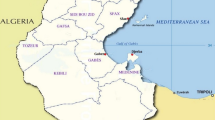Abstract
Amplified fragment length polymorphism (AFLP) was used to determine the genetic diversity among 38 populations of Jatropha curcas L. grown in a seed source trial in Hainan Province of China. The populations studied consisted of one source from Indonesia and 37 sources from the main cultivating areas of jatropha in China, viz. Guangdong (1), Guangxi (10), Guizhou (4), Hainan (6), Sichuan (8) and Yunnan (8). Nine AFLP primer combinations were used to generate a total of 246 fragments, of which 72 (26.99%) were polymorphic. Three-marker attributes: polymorphism information content (PIC), marker index (MI) and resolving power (RP), were all found to be reliable to determine the discriminatory power of the nine primer combinations. The Jaccard’s similarity coefficient showed a high similarity range from 0.866 to 0.977, suggesting a low genetic diversity among the 38 populations. The UPGMA-based dendrogram and biplot of a principal component analysis did not reveal a clear pattern of groupings by geographic locations of the seed sources; populations from across different provinces were mixing in the same groups. The low genetic diversity and a lack of variation pattern among the populations in China suggest that it is necessary to import new germplasm preferably from the species’ natural distribution range to broaden the genetic base for improvement program.


Similar content being viewed by others
References
Anonymous (2007) Jatropha curcas L. introduction. The 2007 biological conference-biological resource. http://218.89.108.58/pt1/kjxxw/html/news/news_view.asp?newsid=1664. Accessed 21 July 2009
Fairless D (2007) The little shrub that could-maybe. Nature 449:652–655. doi:10.1038/449652a
Fernandez M, Figueiras A, Benito C (2002) The use of ISSR and RAPD markers for detecting DNA polymorphism, genotype identification and genetic diversity among barley cultivars with known origin. Theor Appl Genet 104:845–851
Ganesh Ram S, Parthiban KT, Senthil Kumar R, Thiruvengadam V, Paramathma M (2008) Genetic diversity among jatropha species as revealed by RAPD markers. Genet Resour Crop Evol 55:803–809
Gupta PK, Varshney RK (2000) The development and use of microsatellite markers for genetic analysis and plant breeding with emphasis on bread wheat. Euphytica 113(23):163–185
He W, Guo L, Wang L, Yang W, Tang L, Cheng F (2007) ISSR analysis of genetic diversity of Jatropha curcas L. Chin J Appl Environ Biol 13(4):466–470
Heller J (1996) Physic nut-Jatropha curcas L. In: Promoting the conservation and use of underutilized and neglected crops. International Plant Genetic Resources Institute, Rome, Italy. http://www.ipgri.cgiar.org/publications/pdf/161.pdf
Jaccard P (1908) Nouvelles recherches sur la distribution florale. Bull Soc Vaud Nat 44:223–270
Laurentin H, Karlovsky P (2007) AFLP fingerprinting of sesame (Sesamum indicum L.) cultivars: identification, genetic relationship and comparison of AFLP informativeness parameters. Genet Resour Crop Evol 54:1437–1446
Li G, Qulros CF (2001) Sequence-related amplified polymorphism (SRAP), a new marker system based on a simple PCR reaction: its application to mapping and gene tagging in Brassica. Theor Appl Genet 103:455–461
Ou WJ, Wang WQ, Li KM (2009) Molecular genetic diversity analysis of 120 accessions of Jatropha curcas L. germplasm. Chin J Trop Crops 30(3):284–292
Patil V, Singh K (1991) Oil gloom to oil boom—Jatropha curcas a promising agro-forestry crop. Shree Offset Press, Nashik
Powell W, Margenta M, Andre C, Hanfrey M, Vogel J, Tingey S, Rafalsky A (1996) The utility of RFLP, RAPD, AFLP and SSR (microsatellite) markers for germplasm analysis. Mol Breed 2:225–238
Prevost A, Wilkinson M (1999) A new system of comparing PCR primers applied to ISSR fingerprinting of potato cultivars. Theor Appl Genet 98:107–112
Rohlf FJ (2000) NTSYSpc.: numerical taxonomy and multivariate analysis system, version 2.1. Exeter Software, Setauket, NY
Roldan-Ruiz Dendauw J, Van Bockstaele E, Depicker A, De Loose M (2000) AFLP markers reveal high polymorphic rates in ryegrasses (Lolium spp.). Mol Breed 6:125–134
Sneath PHA, Sokal RR (1973) Numerical taxonomy. Freeman Press, San Francisco, USA
Sun QB, Li LF, Li Y, Wu GJ, Ge XJ (2008) SSR and AFLP markers reveal low genetic diversity in the biofuel plant Jatropha curcas in China. Crop Sci 48:1865–1871
Tatikonda L, Wani SP, Kannan S, Beerelli N, Sreedevi TK, Hoisington DA, Devi P, Varshney RK (2009) AFLP-based molecular characterization of an elite germplasm collection of Jatropha curcas L.: a biofuel plant. Plant Sci 176:505–513
Vos P, Hogers R, Bleeker M, Reijans M, van de Lee T, Hornes M, Frijters A, Pot J, Peleman J, Kuiper M et al (1995) AFLP: a new technique for DNA fingerprinting. Nucleic Acids Res 23(21):4407–4414
Williams JG, Kubelik AR, Livak KJ, Rafalski JA, Tingey SV (1990) DNA polymorphisms amplified by arbitrary primers are useful as genetic markers. Nucleic Acids Res 18:6531–6535
Xu SB, Tao YF, Yang ZQ, Chu JY (2002) A simple and rapid method used for silver staining and gel preservation. Hereditas (Beijing) 24:335–336
Zietkiewiez E, Rafalski A, Labuda D (1994) Genome fingerprinting by simple sequence repeat (SSR)-anchored polymerase chain reaction amplification. Genomics 20(2):176–183
Acknowledgments
The study reported here was financially supported by the National Natural Science Foundation of China (30972388), the Natural Science Foundation of Guangdong Province (9351064201000002; 7118121), the National Key Technology Research and Development Program in the 11th 5-year plan of China (2006BAD07A04), the Science and Technology Program of Guangdong Province (2007B020703003/0711150100089), and the Forestry Science and Technology Innovation Program of Guangdong Province (2008KJCX006). We thank Mr Khongsak Pinyopusarerk and Mr Charlie Bell of CSIRO Plant Industry, Australia for valuable comments on an early draft.
Author information
Authors and Affiliations
Corresponding author
Additional information
Communicated by F. Canovas.
Rights and permissions
About this article
Cite this article
Shen, Jl., Jia, Xn., Ni, Hq. et al. AFLP analysis of genetic diversity of Jatropha curcas grown in Hainan, China. Trees 24, 455–462 (2010). https://doi.org/10.1007/s00468-010-0413-1
Received:
Revised:
Accepted:
Published:
Issue Date:
DOI: https://doi.org/10.1007/s00468-010-0413-1




